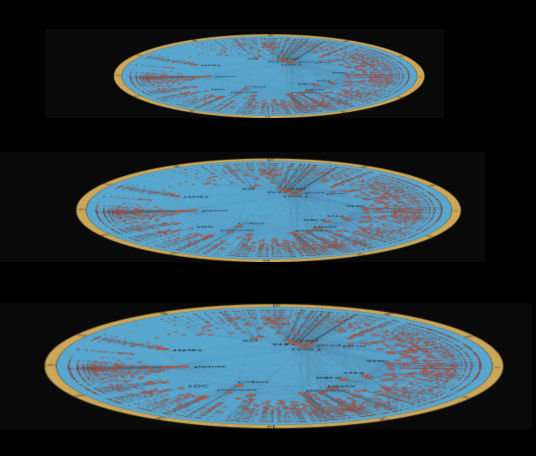A new technique allows researchers to create real system cartographic maps at different scales

Researchers at the Institute of Complex Systems of the University of Barcelona (UBICS) have developed a method to represent network systems, such as postal services and the internet, at different scales, as if they were cartographic maps.
UBICS researchers M. Ángeles Serrano, Guillermo García-Pérez and Marián Boguñá, who conducted the study published in Nature Physics, applied a renormalization group technique to real-world systems. "This technique allows us to explore a system at different resolution levels, such as a kind of inverted microscope that allows us to zoom out and widen the scale at which we make the observation," says the ICREA research lecturer M. Ángeles Serrano, director of the study.
"Being able to move around a network at several scales is very important in systems in which you have many interacting elements, such as the networks we studied. These systems are multiscale networks, that is, their structure or associated processes result from a mix of structures and processes at different scales," says Guillermo García-Pérez, first author of the study. "Each scale has specific data, but scales are also interrelated between them," he says.
Representing reality as complex networks
The UB researchers applied the technique they developed to the above mentioned systems. Although they are different, all of them can be defined in the shape of nodes and connections. In some cases, for example in music, researchers regard chords as nodes and connections.
In any case, all these systems can be defined via the "small-world property" as complex networks, because the nodes are connected in only a few steps. "It is because of the small-world property that it had been impossible to split structural scales in real complex networks, and in order to do so, we had to develop geometric maps on each one of them so we could define the distances between nodes," says Marián Boguñá.
Moreover, these networks exhibit two more features: They have a heterogeneous connectivity, i.e., have elements with a high connectivity and others with low connectivity; and they display many node groupings in a triangular shape (clustering).
"This is the first time a really geometric renormalization group has been defined in complex networks," says Ángeles Serrano, who adds "We can now build maps of complex networks in the most cartographical sense of the word, real maps where elements or nodes have positions and distance between them. These maps are not only attractive visual representations, but they are full of meaning, and they allow us to find out information on the systems and to navigate through them. We can increase the system navigability if we take into account the information provided by the renormalization group, which allows us to unfold networks at the different scales that build them up, and which, in addition, turn out to be self-similar, that is, they have the same organization at different scales."
These results can also be applied to make reduced versions of the original networks at smaller scales with the same properties. "The possibility of having reduced copies has a great potential; for instance, they can serve as a test bench to assess expensive processes in original networks, such as new Internet routing protocols," concludes Serrano.
More information: G. García-Pérez, M. Boguñá and M. Á. Serrano. "Multiscale unfolding of real complex networks by geometric renormalization". Nature Physics, March 19, 2018. DOI: 10.1038/s41567-018-0072-5
Journal information: Nature Physics
Provided by University of Barcelona



















